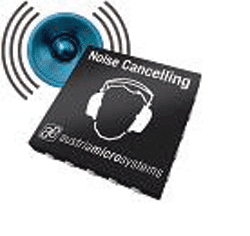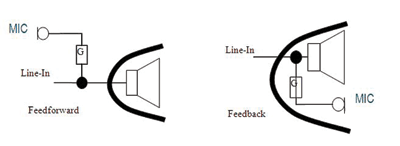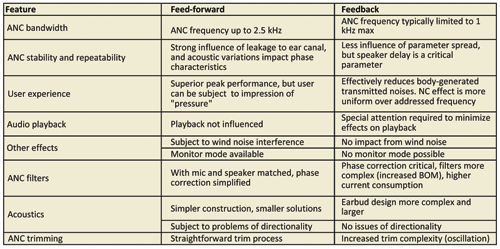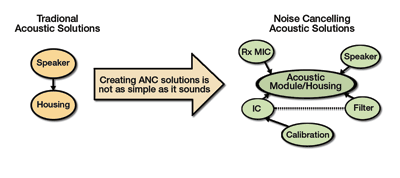Cancelling ambient noise in portable multimedia devices
Developing ANC solutions is not as easy as it sounds
BY OLIVER JONES
Marketing Manager for Audio Products
austriamicrosystems
www.austriamicrosystems.com
Cell phones and portable multimedia players (PMPs) have undergone two dramatic changes in recent years. One, the cost for a basic cell phone has plummeted to the point that most of the world’s population can obtain a phone. And two, higher-end and smart phones have increasingly added features and improved performance, all while maintaining reasonable battery life in between charges. However, all mobile phone users can identify with the annoying problem of trying to hear music or a caller above the ambient noise surrounding them.

Noise cancellation removes those unwanted environmental sounds so as to enhance the clarity of sound playing through your music player, or so that you can understand what the person on the other end of the phone is saying, or simply to enjoy a little peace and quiet.
Removing unwanted sound
There are basically two ways to remove unwanted sounds; one is a passive technique where the ear is mechanically insulated from the environment by either sticking your fingers in your ears or using earplugs or earmuffs made of plastic, foam, rubber silicon, or some other material. The other way is to use an active technique where a diaphragm is driven to generate an anti-noise signal.
One convenient property of sound is that sound waves are additive. If you create a mirror image of the noise arriving at the ear and then play this mirror image in perfect synchronization with the noise, the result is total quiet.
The active technique requires an electroacoustic solution to interpret the noise, generate the necessary signals, and then drive a diaphragm or speaker. This sounds simple, but in practice, things get a little more complex.
To create an accurate antinoise signal, you need to “listen” to the noise as close as possible to the ear canal. Any signal measurement takes a finite amount of time, so the “listener” (microphone) must be sufficiently far enough away from the speaker so that there is enough time to complete the signal processing and generate the anti-noise. This “conflict of interests” is one of the limiting factors affecting the overall system performance.
The behavior of the electroacoustic components is the other factor. Sensitivity and phase shifts over frequency complicate the task of the designer of active noise-cancelling (ANC) solutions. Microphones, speakers, and the mechanical construction of an earbud or headphone can have significant influence on the phase and gain response of the system.
Active noise-cancelling solutions
ANC solutions are typically divided into two architectures: one uses a feed-forward topology where the microphone is pointed away from the ear, and the other, called a feedback topology, places the microphone close to the speaker listening to the sounds in and around the ear cavity (see Fig. 1 ).

Fig. 1: Typical active noise-cancellingANC architectures include feed-forward and feedback topologies.
In feed-forward systems, the microphone-to-speaker isolation also plays an important role. If the ambient noise-detecting microphones pick up some of the music or conversation, the electronics will interpret this information as unwanted noise and therefore try to cancel it.
Since the microphone picks up both music and noise, feedback systems rely on a simple subtraction of the line-in information (being played from the speaker) from the microphone output to acquire the noise that needs to be cancelled. The result is then filtered and added back to the line-in signal. The design of the filter is critical. You must ensure you don’t inadvertently cancel information that you want to listen to, but you also have to make sure that the system doesn’t enter into oscillation.
A new generation of headsets is currently being proposed which combines both feed-forward and feedback topologies; the objective being to use the best of both worlds. Table 1 summarizes the key differences between feed-forward and feedback techniques.

Table 1: Key differences between feed-forward and feedback techniques
Minimizing inconvenience
As earbuds evolve with new shapes and materials, the time required to get a snug and comfortable fit in your ear takes longer. Interruptions can therefore become a problem. For example, imagine you want to hear an announcement or your neighbor needs to ask you something. Rather than rip the earbuds out of your ears, most ANC solutions have a button that interrupts the noise cancelling; unfortunately, you’re still stuck with the passive attenuation of the earbud itself. As an alternative, austriamicrosystems solutions provide an active assisted-hearing mode. This approach allows the user to attenuate the line-in signal without necessarily removing it entirely; at the same time the outside noise is amplified to overcome the passive attenuation of the headset.
Designing ANC systems
The design of an ANC headset is not as simple as gluing a microphone and filter to an existing headset. Traditional headsets rely on choosing the right speaker and designing the front and rear cavities to ensure good acoustic performance (see Fig. 2 ).

Fig. 2: Traditional headsets versus active noise-cancellingANC headsets.
ANC headsets depend on the proper choice of microphone, speaker, cavity, electronic control circuitry and filter. The designer must also take into consideration how the headset is manufactured and trimmed to ensure the best noise-cancelling performance. In addition, the designer needs to ensure the necessary artifacts are combined to create a good acoustic rendition.
In fact, the very same characteristics exploited in traditional systems to obtain good sounding acoustics are often contradictory to what is needed to create a high-performance ANC headset. Specifically, acoustic bass boost and phase shift cause significant issues for the ANC system designer.
The ideal ANC headset has a totally flat response over frequency for gain and phase of both the speaker and the microphone, which does not sound very good. This leads to either a compromise in ANC performance or the need to condition the line-in signal to create a “rounder” sound.
However, when designing in-ear canal earbuds, this compromise is minimized. For larger supra-concha headsets, the resonance and phase shifts occurring outside of the typical frequency band of interest for ANC have a significant impact on the ANC vs. acoustic tradeoff.
Considering manufacturability
Low-cost electret condenser microphones appear to offer cost savings but typically have quite large tolerances on their sensitivity, imposing the use of calibration to ensure balanced results. Contemporary solutions rely on potentiometers that are manually fine-tuned on the assembly line. However, recent innovative solutions, such as ANC ICs from austriamicrosystems, integrate fine-tuning capability as an electronically programmable function, significantly improving productivity and simplifying the production flow.
Analog vs. digital
The designer can choose either a digital or an analog signal-processing approach. The traditional digital solution relies primarily on prediction and enables excellent noise cancelling for “steady-state” noise; for example, constant engine noise or other constant frequency sounds. Such solutions are typically characterized by a turn-on delay of one or two seconds while the control loop “listens” to the environment and analyzes the steady-state components of noise.
However, changes in the noise spectrum cannot be matched instantaneously. More recent developments in the digital domain allow for good real-time performance for feed-forward systems at the cost of battery power to minimize the effects of the latency caused by the ADC, signal processing, and DAC delays.
One of the advantages of digital-based approaches is that the development of the solution becomes more mathematical and software oriented. The other advantage is that the designer can introduce artifacts such as equalization, bass boost, surround sound, and so on. But all of this is at the cost of additional computing and power consumption.
The analog approach is more empirical and relies on a good deal of electroacoustic expertise, but it offers additional advantages beyond size and cost.
Analog solutions for ANC are preferable for two reasons: first, they react instantaneously and second, they use much less power than digital solutions of similar performance, which is critical for portable electronic products. ■
Advertisement
Learn more about ams (formerly austriamicrosystems)





